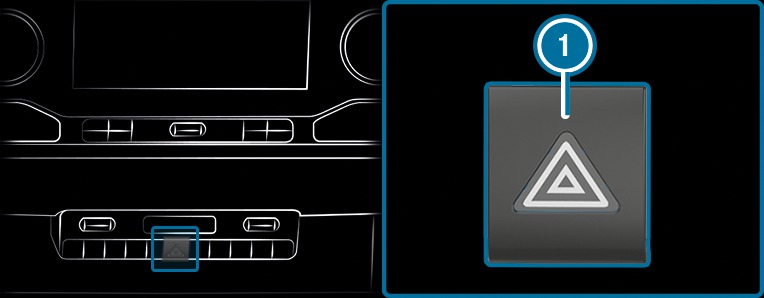
 .
. If you operate a turn signal indicator while the hazard warning light system is switched on, only the turn signal lamps on the relevant side of the vehicle will light up.
The airbag is deployed
The vehicle is heavily braked from a speed of more than 70 km/h to a standstill.
If the hazard warning light system has automatically switched on, press hazard warning lamp switch  to switch it off.
to switch it off.
The hazard warning light system will automatically switch off when the vehicle regains a speed of more than 10 km/h after maximum full-stop braking.
The hazard warning light system will work even when the vehicle has been switched off.
A fire extinguisher may impede pedal travel or block a depressed pedal.
This jeopardises the operating and road safety of the vehicle.
The fire extinguisher can be flung around and injure the driver or other vehicle occupants.
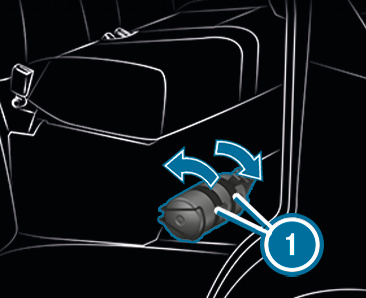
 upwards.
upwards.  downwards.
downwards. In a right-hand-drive vehicle, the fire extinguisher is located on the co-driver's seat on the left when viewed in the direction of travel.
The warning triangle is located in the stowage compartment in the front passenger door.
The first-aid kit (soft sided) is located in the stowage compartment in the front passenger door.
The QR code stickers are affixed to the B-pillar on the driver's and co-driver's side. In the event of an accident, emergency services can use the QR code to quickly determine the corresponding rescue card for your vehicle. The current rescue card contains, in compact form, the most important information about your vehicle e.g. the routing of electric cables.
Further information can be obtained at Mercedes-Benz homepage - rescue card.
When charging using a battery charger without a restriction of the maximum charging voltage, the battery or the on-board electronics can be damaged.
There is a danger of hydrogen gas igniting when charging the battery if there is a short circuit or sparks start to form.
During the charging process and starting assistance, the battery may release an explosive gas mixture.
A discharged battery may freeze at temperatures slightly above or below freezing point.
During starting assistance or battery charging, battery gas can be released.
If the warning/indicator lamps do not light up in the instrument display around or below freezing point, it is very likely that the discharged battery has frozen.
do not give the vehicle starting assistance or charge the battery
the service life of a battery that has been thawed may be reduced drastically
the starting behaviour may deteriorate, particularly at low temperatures
it is recommended that you have a thawed battery checked at a qualified specialist workshop
Numerous or extended attempts to start the engine may damage the catalytic converter due to non-combusted fuel.
only use undamaged jump leads/charging cables with a sufficient cross-section and insulated terminal clamps
non-insulated parts of the terminal clamps must not come into contact with other metal parts while the jump leads/charging cables are connected to the battery/jump-start connection point
the jump leads/charging cables must not come into contact with any parts which may move when the engine is running
make sure that neither you nor the battery is electrostatically charged
avoid fire and naked flames
do not lean over a battery
when charging: only use a battery charger that has been tested and approved by Mercedes-Benz and read the operating instructions for your charger before charging the batteries
starting assistance may only be provided using batteries with a nominal voltage of 12 V.
the vehicles must not touch each other
vehicles with a petrol engine: only perform starting assistance when the engine and exhaust system are cold
 .
. 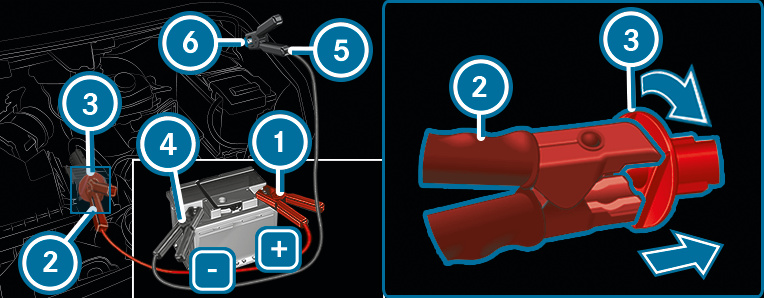
Right-hand drive vehicle: the jump-start connection may be on the opposite side.
 of the starting assistance/charging cable to the POSITIVE terminal of the donor battery.
of the starting assistance/charging cable to the POSITIVE terminal of the donor battery.  of the starting assistance/charging cable, slide the red protective cap on jump-start connection
of the starting assistance/charging cable, slide the red protective cap on jump-start connection  back with a clockwise turn.
back with a clockwise turn.  to the POSITIVE terminal of jump-start connection
to the POSITIVE terminal of jump-start connection  .
.  of the starting assistance/charging cable to the NEGATIVE terminal of the donor battery.
of the starting assistance/charging cable to the NEGATIVE terminal of the donor battery.  of the starting assistance/charging cable to earth point
of the starting assistance/charging cable to earth point  on your own vehicle (bare metal part in the engine compartment).
on your own vehicle (bare metal part in the engine compartment). When the starting assistance/charging process is complete:
 from earth point
from earth point  in the engine compartment, then black NEGATIVE terminal clamp
in the engine compartment, then black NEGATIVE terminal clamp  from the donor battery. Then remove second red POSITIVE terminal clamp
from the donor battery. Then remove second red POSITIVE terminal clamp  from the POSITIVE terminal of jump-start connection
from the POSITIVE terminal of jump-start connection  , followed by red POSITIVE terminal clamp
, followed by red POSITIVE terminal clamp  on the donor battery.
on the donor battery. The red protective cap springs back to its initial position when second red POSITIVE terminal clamp  is disconnected from jump-start connection
is disconnected from jump-start connection  .
.
You can obtain further information at a qualified specialist workshop.
If you manipulate or bridge a faulty fuse or if you replace it with a fuse with a higher amperage, the electric line could be overloaded.
This could result in a fire.
Electrical components or systems could be damaged by incorrect fuses.
The electrical fuses in your vehicle switch off defective circuits. If a fuse blows, all the components on the circuit and their functions will cease to operate.
Blown fuses must be replaced with fuses of an equivalent specification, which you can determine by the colour and fuse rating. The fuse allocation chart and further information on the electric fuses and relays can be found in the "Fuse allocation chart" supplement.
Moisture may cause damage to the electrical system or cause it to malfunction.
If the new fuse which has been inserted also blows, have the cause traced and rectified at a qualified specialist workshop.
the vehicle is secured such that it does not roll away
all electrical consumers are switched off
the ignition is switched off
A flat tyre strongly impairs the vehicle's driving characteristics, as well as its steering and braking characteristics.
You can make a breakdown assistance call using the breakdown assistance call button in the overhead control panel .
Change the wheel More.
Jack
Wheel wrench
You will find the maximum load capacity of the jack stated on the adhesive label attached to the jack.
The jack is maintenance-free. If there is a malfunction, please contact a qualified specialist workshop.
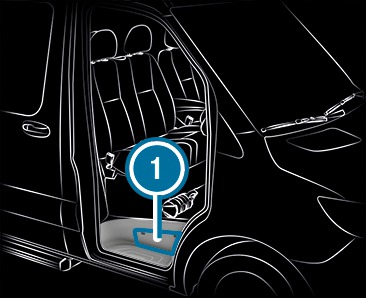
The tyre-change tool kit is located in the stowage compartment  above the step of the co-driver's door and in the stowage compartment in the footwell on the co-driver side.
above the step of the co-driver's door and in the stowage compartment in the footwell on the co-driver side.
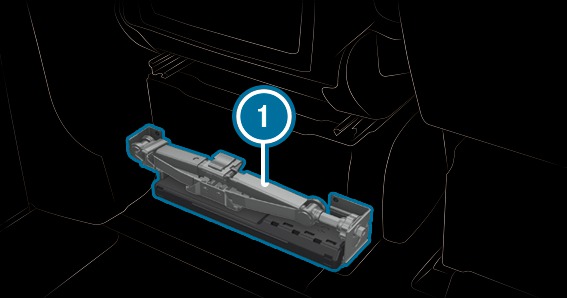
The tyre-change tool kit  is located behind the driver's seat.
is located behind the driver's seat.
In the event of a breakdown, Mercedes-Benz recommends that you have the vehicle transported instead of towed.
A vehicle with a front wheel drive and automatic transmission may be damaged if it is pushed or towed too far and too fast when the engine is switched off.
Vehicles with automatic transmission and rear wheel drive: if there is a malfunction, the automatic transmission may be locked in position  .
.
If the automatic transmission cannot be shifted to position  , transport the vehicle More. A towing vehicle with lifting equipment is required for vehicle transport.
, transport the vehicle More. A towing vehicle with lifting equipment is required for vehicle transport.
Vehicles with automatic transmission and front wheel drive: if there is a malfunction, the automatic transmission may be locked in position  . You can release the parking lock manually More.
. You can release the parking lock manually More.
If the automatic transmission cannot be shifted to position  , transport the vehicle More. A towing vehicle with lifting equipment is required for vehicle transport.
, transport the vehicle More. A towing vehicle with lifting equipment is required for vehicle transport.
 Both axles on the ground |  Front axle raised |  Rear axle raised |
|---|---|---|
Yes, no further than 100 km at 50 km/h | Yes, no further than 100 km at 50 km/h | Yes, no further than 50 km at 50 km/h |
 Both axles on the ground |  Front axle raised |  Rear axle raised |
|---|---|---|
Yes, no further than 50 km at 50 km/h | Yes, no further than 50 km at 50 km/h | Yes, if the steering wheel is fixed in the centre position with a steering wheel lock |
 Both axles on the ground |  Front axle raised |  Rear axle raised |
|---|---|---|
No (when the engine is switched off) Yes (when the engine is running), maximum 5 km at 20 km/h | Yes | No (when the engine is switched off) Yes (when the engine is running), maximum 5 km at 20 km/h |
 Both axles on the ground |  Front axle raised |  Rear axle raised |
|---|---|---|
Yes, no further than 50 km at 50 km/h | No | No |
Towing with a raised axle: towing should be performed by a towing company.

